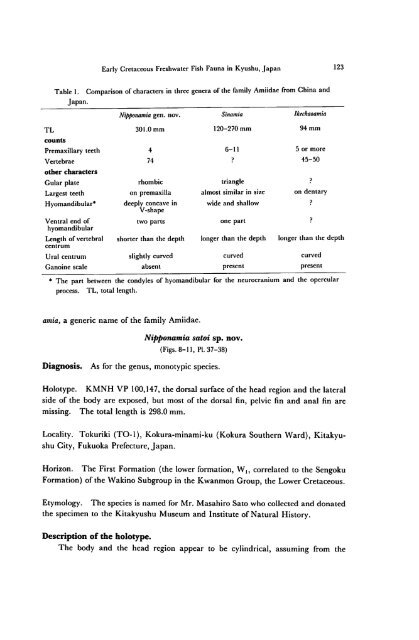Early Cretaceous Freshwater Fish Fauna in Kyushu, Japan
Early Cretaceous Freshwater Fish Fauna in Kyushu, Japan
Early Cretaceous Freshwater Fish Fauna in Kyushu, Japan
You also want an ePaper? Increase the reach of your titles
YUMPU automatically turns print PDFs into web optimized ePapers that Google loves.
<strong>Early</strong> <strong>Cretaceous</strong> <strong>Freshwater</strong> <strong>Fish</strong> <strong>Fauna</strong> <strong>in</strong> <strong>Kyushu</strong>,<strong>Japan</strong><br />
123<br />
Table 1.<br />
<strong>Japan</strong>.<br />
Comparison ofcharacters <strong>in</strong> three genera ofthe family Amiidae from Ch<strong>in</strong>a and<br />
Nipponamia gen. nov. S<strong>in</strong>amia Ikechaoamia<br />
TL 301.0 mm 120-270 mm 94 mm<br />
counts<br />
Premaxillary teeth<br />
Vertebrae<br />
other characters<br />
4<br />
74<br />
6-11<br />
7<br />
5 or more<br />
Gular plate rhombic triangle<br />
p<br />
45-50<br />
Largest teeth on premaxilla almost similar <strong>in</strong> size on dentary<br />
Hyomandibular*<br />
Ventral end of<br />
hyomandibular<br />
Length of vertebral<br />
centrum<br />
deeply concave <strong>in</strong><br />
V-shape<br />
two parts<br />
shorter than the depth<br />
wide and shallow<br />
one part<br />
longer than the depth<br />
p<br />
p<br />
longer than the depth<br />
Ural centrum slightly curved curved curved<br />
Gano<strong>in</strong>e scale absent present present<br />
* The part between the condyles of hyomandibular for the neurocranium and the opercular<br />
process. TL, total length.<br />
amia, a generic name of the family Amiidae.<br />
Nipponamia satoi sp. nov.<br />
(Figs. 8-11, PL 37-38)<br />
Diagnosis.<br />
As for the genus, monotypic species.<br />
Holotype. KMNH VP 100,147, the dorsal surface of the head region and the lateral<br />
side of the body are exposed, but most of the dorsal f<strong>in</strong>, pelvic f<strong>in</strong> and anal f<strong>in</strong> are<br />
miss<strong>in</strong>g. The total length is 298.0 mm.<br />
Locality. Tokuriki (TO-1), Kokura-m<strong>in</strong>ami-ku (Kokura Southern Ward), Kitakyu<br />
shu City, Fukuoka Prefecture, <strong>Japan</strong>.<br />
Horizon. The First Formation (the lower formation, W,, correlated to the Sengoku<br />
Formation) of the Wak<strong>in</strong>o Subgroup <strong>in</strong> the Kwanmon Group, the Lower<strong>Cretaceous</strong>.<br />
Etymology. The species is named for Mr. Masahiro Sato who collected and donated<br />
the specimen to the Kitakyushu Museum and Institute of Natural History.<br />
Description of the holotype.<br />
The body and the head region appear to be cyl<strong>in</strong>drical, assum<strong>in</strong>g from the

















